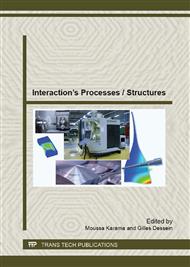[1]
E. Tekkaya, State-of-the-art of simulation of sheet metal forming J. of Mate. Proc. Tech., Vol. 103, Issue 1, 1 June 2000, 14-22
Google Scholar
[2]
S. H. Zhang, Developments in hydroforming, J. of Mate. Proc. Tech., vol. 91, 1999, 236-244.
Google Scholar
[3]
J. Lemaitre, A continuum damage mechanics model for ductile fracture, J. of Eng. Mat. Tech. vol. 107, 1985, 83-89.
Google Scholar
[4]
A-L. Gurson, Continuum theory of ductile rupture by void nucleation and growth. Part I: Yield criteria and flow rules for porous ductile media, J. of Eng. Mat. Tech. Vol. 99, 1977.
DOI: 10.2172/7351470
Google Scholar
[5]
P. Teixeira, A-D. Santos, F.M. Andrade Pires, J-M-A. Cesar de S´a., Finite element prediction of ductile fracture in sheet metal forming processes, J. of Mat. Processing Tech, vol. 177, 2006, 278–281.
DOI: 10.1016/j.jmatprotec.2006.04.059
Google Scholar
[6]
A. Cherouat, K. Saanouni, Y. Hammi, Numerical improvement of thin tubes hydroforming with respect to ductile damage, Int J. of Mech. Sciences, vol. 44 (12), 2002, 2427-2446.
DOI: 10.1016/s0020-7403(02)00177-7
Google Scholar
[7]
N. Abedrabbo, Michael A. Zampaloni, F. Pourboghrat Wrinkling control in aluminum sheet hydroforming, Int. J. of Mech. Sci., Vol. 47, Issue 3, March 2005, 333-358
DOI: 10.1016/j.ijmecsci.2005.02.003
Google Scholar
[8]
S. H. Zhang, Z. R. Wang, Y. Xu, Z. T. Wang, L. X. Zhou Recent developments in sheet hydroforming technology, J. of Mate. Proc. Tech., Vol. 151, Issues 1-3, 2004, 237-241
DOI: 10.1016/j.jmatprotec.2004.04.054
Google Scholar
[9]
Takayuki Hama, Tomohiro Hatakeyama, Motoo Asakawa, Hiroyuki Amino, Akitake Makinouchi, Hitoshi Fujimoto, Hirohiko Takuda, Determination of optimal loading profiles in warm hydroforming of lightweight materials, J. of Mate. Proc. Tech., Vol 190, Issues 1-3, 23, 2007, 230-242.
DOI: 10.1016/j.jmatprotec.2007.02.040
Google Scholar
[10]
N. Siva Prasad Varma, R. Narasimhan, Alan A. Luo, A.K. Sachdev , An analysis of localized necking in aluminium alloy tubes during hydroforming using a continuum damage model, I. J. of Mech. Sciences, vol. 49 (2), 200-209, 2007.
DOI: 10.1016/j.ijmecsci.2006.08.005
Google Scholar
[11]
Ch. Hartl, Research and advances in fundamentals and industrial applications of hydroforming, J. of Mate. Proc. Tech., Vol 167, Issues 2-3, 30, 2005, 383-392
Google Scholar
[12]
L. Lang, J. Danckert, K. Brian Nielsen, X. Zhou. Investigation into the forming of a complex cup locally constrained by a round die based on an innovative hydromechanical deep drawing method, J. of Mate. Proc. Tech., Vol 167, Issues 2-3, 30, 2005, 191-200.
DOI: 10.1016/j.jmatprotec.2005.06.030
Google Scholar
[13]
MATLAB Users Manual, The Mathworks Inc., 2007.
Google Scholar
[14]
ABAQUS, Theory Manual, Version 6.7, Hibbit, Karson & Sorensen, 2008.
Google Scholar
[15]
S. Zhang, L. Zhou, Zhong-Tang Wang, Yi Xu Technology of sheet hydroforming with a movable female die, International Journal of Machine Tools and Manufacture, Vol. 43, Issue 8, June 2003, 781-785.
DOI: 10.1016/s0890-6955(03)00057-9
Google Scholar
[16]
A. Assempour, M. Reza Emami Pressure estimation in the hydroforming process of sheet metal pairs with the method of upper bound analysis, J. of Mate. Proc. Tech., Vol. 209, Issue 5, 1 March 2009, 2270-2276.
DOI: 10.1016/j.jmatprotec.2008.05.020
Google Scholar
[17]
J. Tsujino, K. Hidai, A. Hasegawa, R. Kanai, H. Matsuura, K. Matsushima, T. Ueoka, Ultrasonic butt welding of aluminium, aluminium alloy and stainless steel plate specimens Ultrasonics, vol. 40(1-8), 371-374, (2002)
DOI: 10.1016/s0041-624x(02)00124-5
Google Scholar
[18]
W. Spendley, G.R. Hext and F.R. Himsworth: Technometrics Vol. 4 (1962), pp.441-461
Google Scholar
[19]
F. van den Bergh: An analysis of particle swarm optimizers, Ph.D. dissertation, University of Pretoria, Pretoria (2001).
Google Scholar
[20]
R. Fletcher: Practical Methods of Optimization (John Wiley & Sons, Chichester, 1987).
Google Scholar
[21]
R. Barton and J.S. Ivey: Management Science Vol. 42 (1996), pp.954-973.
Google Scholar
[22]
L. Nazareth, P. Tzeng and Gilding the lily: Computational Optimization and Applications Vol. 22 (2002), pp.133-134.
Google Scholar


